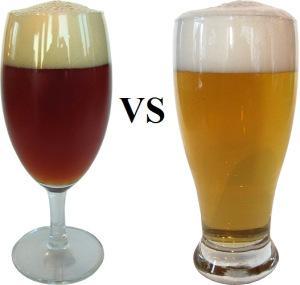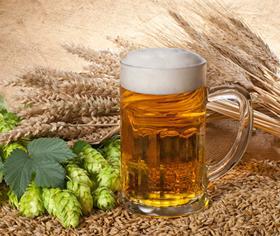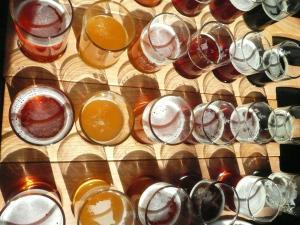I was recently introduced to Man Crates, who have some awesome gifts for guys. They posed the question, what would help a beginner that is looking to get into beer. So I thought about it a bit and came to the conclusion that we should start at the beginning with a foundation discussion of beer types, ingredients and styles.
Beer is an exceptionally complex creation that, as the craft beer renaissance continues, is also exceedingly intimidating. There is a dizzying number of styles to choose from each described in terms that sound like they come from a different language. But, fear not gentle neophyte, we are here to help.

Source: http://zencrumble.com/ale-vs-lager-whats-difference/
Beer Types
Whether you want to learn about beer for your own edification or so that you can follow a beer-centric conversation without having to ask for translation, every beer drinker should know what type of beer they drinking. To clarify, there are two main types of beer, but many different styles. According to the Beer Judge Certification Program Style Guide (2008 Edition) there are 23 distinct beer styles, each with multiple sub-styles. The 2014 Great American Beer Festival guidelines list 90 styles with multiple sub-styles. But, we will talk more about styles later.
As noted above, there are two main beer types; ale and lager. The major differences between the two lie in the yeast that is used and how they are fermented.
Ales are fermented at warmer temperatures and employ top-fermenting yeast. That is to say, the yeast tends to float towards the top of a fermentation tank as it works its miracle on sugars suspended in the liquid. Ales were the first type of beer discovered and have roots that extend more than 9,000 years into history. Ales tend to have robust flavors and higher alcohol content.
Lagers are made with bottom-fermenting yeast and require cooler temperatures – around 40 to 55F. They also require longer for fermentation to complete. The term lager comes from the Germany word for storing the beer in cool caves or lagerung. Because of the longer fermentation time and cooler temperatures, lagers tend to have lighter, crisper flavors.

Source: http://www.germanfoodguide.com
Beer Ingredients
Now that you know the two types of beer, it is important to understand what ingredients besides yeast go into the final product. In its purest form beer consists of just four components; water, malt, yeast and hops.
Water is arguably the most important ingredient in the mixture that comprises beer. Without this single, abundant element beer would never have been discovered. But, different water results in different beer. Indeed, entire styles of beers have resulted because of the type of water available. The relative hardness or softness of water can impart very different flavors due to mineral content.
Malt usually refers to barley that has been allowed to begin to sprout before being dried in a kiln. But, other grains such as rye, wheat and oats can be used in the brewing process. The type of malt and the amount that it is roasted in the kiln plays a major role in the characteristics of the finished beer.
Yeast strains are not restricted to just top and bottom fermenting. Within those two categories are hundreds of strains that impart different flavor profiles in to beer. Some brewers even allow their beer to be inoculated by wild yeasts to elicit sour or funky flavors.
Hops are the flower cones of the hops plant. Added during the boil phase of brewing beer, hops contribute the distinctive bitter flavor evident in most beer. In addition, hops are a natural preservative and contribute to stabilizing beer for storage over a period of time.
In the hands of a master brewer, these four ingredients can be transformed into literally scores of different beer styles. But, when adjuncts are added such as corn, rice or fruit, the possibilities open further.

Source: http://www.womenenjoyingbeer.com
Beer Styles
So, now that you know about basic beer types and ingredients, it is time to have a discussion on styles. The most popular style of beer in the world is the light lagers produced by huge corporate beer conglomerates. These beers tend to be light to medium yellow in color, highly carbonated and are mild in flavor. Most of these light lagers are brewed to closely approximate the German pilsner style. But, there are many more styles with much more flavor to choose from.
With more than 90 styles and at least that many sub-styles, getting to know them all can be daunting. So, in order to keep it simple, we will only look at the major styles and their characteristics. By far the most popular styles are:
- Pilsner
- Wheat
- Pale Ale
- India Pale Ale (IPA)
- Stout and Porter
Pilsners are lagers and are generally straw to light gold in color and crystal clear. They have aromas of grain, yeast, flowers and some bitterness. They are crisp, slightly bitter and maybe a bit biscuity in flavor. This style takes its name from the city of Plzeň, Bohemia, Czech Republic, where it was first produced in 1842. Later the Germans began producing the style and to this day many people mistakenly attribute the style to the Germans.
Wheat beers are ales and as a general style are cloudy and range in color from pale straw to dark gold. When you smell a wheat beer you are likely to get hints of banana, cloves, grain and perhaps sweet citrus. A sip should provide a mild to strong banana and clove flavor as well as a slight tart tang. Brewers often add orange peel, cardamom and coriander to this style so these flavors may be present as well. These beers may be referred to as heffeweizen, weizen, witbier or wit.
Pale ales are, as the name implies, ales that range from pale gold to deep amber in color. They usually have a moderate aroma of hops that might include pine or citrus. On the tongue pale ales generally show off their moderate hop characteristic with a balanced, mildly sweet malty backbone. Pale ales that are brewed in the Burton upon Trent, UK are considered to be the best in the world to the high gypsum content of the local water.
IPAs are ales that are clear and have a range of colors from deep gold to reddish copper. Aromas from IPAs are heavy on hop bitterness and can include pine, citrus, resin, floral or fruity. The flavor can be mildly hoppy to bitingly bitter with an assertively sweet malt backbone. IPAs began in England and were formulated to survive long voyages by sea better than other styles.
Stouts and porters, while technically two different styles, share many of the same characteristics. These dark brews range in color from light brown to black. Aromas you will experience with both can include coffee, chocolate, dark fruits, toffee, caramel and even cream. A taste of these styles may present flavors that match the aromas as well as others like burnt toast, hop bitterness and sweet cream. Stouts are generally considered heavy beers than porters in flavor but, not necessarily in alcohol. Porters were said to be favored by the baggage handlers in London’s train stations, thus the name. Both styles are often carbonated with nitrogen rather than carbon dioxide producing a creamier, richer mouthfeel.
As a starting point, the information presented here can be used to springboard into more learning. The world of beer is full of traditions, customs and practices. There are many more styles of beer to discover as you taste your way through craft beer culture. In addition, each style has an optimal style of glassware created to enhance its specific characteristics. The best way to learn is to simply try new things, read as much as you can and enjoy the camaraderie of friends over a delicious well-crafted beer.
